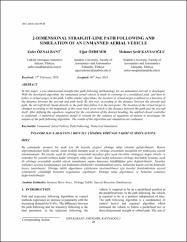2-Dimensional Straight-Line Path Following and Simulation of an Unmanned Aerial Vehicle
Özet
In this paper, a two-dimensional-straight-line path following methodology for an unmanned aircraft is developed. With the developed algorithm, the unmanned aerial vehicle is made to converge to a predefined path, and then to follow a virtual target on the path. Unlike similar algorithms, the location of virtual target is defined as a function of the distance between the aircraft and path itself. By this way, according to the distance between the aircraft and path, the aircraft firstly heads directly to the path then follow it to the next point. The location of the virtual target is changed according to the magnitude of the cross track error which is the distance between the path and the aircraft itself. After defining the equations required for the calculation of the desired heading, the applied closed controller is explained. A numerical simulation model is created for the solution of equations of motion to investigate the outputs of the path following algorithm. The results of the algorithm and simulation are evaluated. Bu çalışmada, insansız bir uçak için iki boyutlu çizgisel yörünge takip yöntemi geliştirilmiştir. Benzer algoritmalardan farklı olarak, sanal hedefin konumu uçak ve yörünge arasındaki mesafenin bir fonksiyonu olarak tanımlanmıştır. Bu sayede, uçak ile yörünge arasındaki mesafeye göre uçak öncelikle yörüngeye doğru yönelir ve ardından bir sonraki noktaya kadar yörüngeyi takip eder. Sanal hedef noktasının yörünge üzerindeki konumu, uçak ile yörünge arasındaki uzaklık olarak tanımlanan sapma hatasının büyüklüğüne göre değiştirilmiştir. İstenilen istikamet açısının hesaplanması için kullanılan denklemler tanımlandıktan sonra, kullanılan kapalı çevrim kontrolör kısaca tanıtılmıştır. Yörünge takibi algoritması çıktılarının incelenebilmesi için hareket denklemlerinin sayısal yöntemlerle çözüldüğü benzetim uygulaması yapılmıştır. Yörünge takip algoritması ve benzetim sonuçları değerlendirilmiştir.
Kaynak
Havacılık ve Uzay Teknolojileri DergisiCilt
11Sayı
2Bağlantı
http://www.trdizin.gov.tr/publication/paper/detail/TWpnM05qUTJOZz09https://hdl.handle.net/11421/18566


















